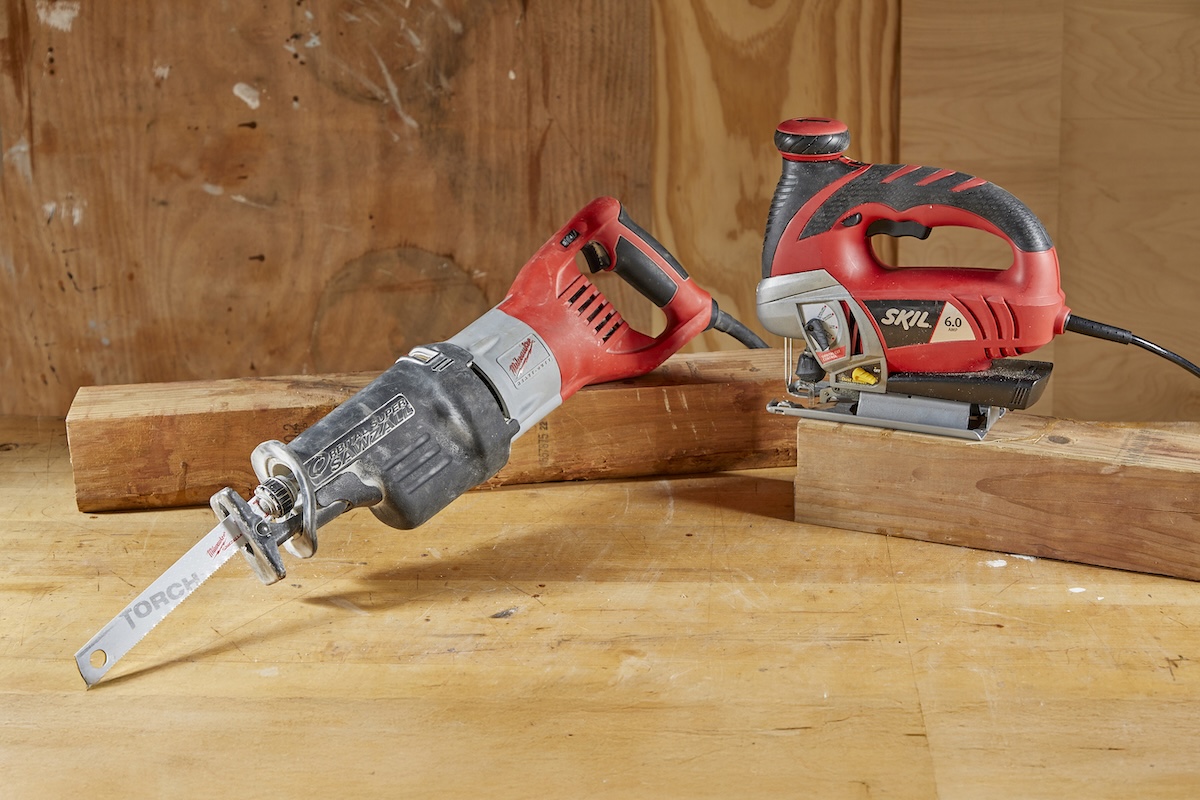

We may earn revenue from the products available on this page and participate in affiliate programs. Learn More ›
Reciprocating saws and jigsaws are both popular tools capable of a multitude of DIY and professional tasks. While both mimic the action of hand sawing to an extent and are available as corded or cordless models, their design and uses are quite different.
The reciprocating saw is a great choice for general sawing tasks, remodeling, cutting pipework and conduit. The jigsaw is more often a woodworker’s or carpenter’s tool, and it’s also found on job sites. A closer look at a few important details will reveal the differences and answer many jigsaw vs. reciprocating saw questions.
Reciprocating saws feature a horizontal hognose design while jigsaws are more compact and vertical.
Jigsaws have a handle along the top of a compact body, often incorporated in the same molding. The blade is at 90 degrees to the bulk of the jigsaw, sticking out from underneath, close to the front. A transparent shield that slides up and down is a common safety feature.
The reciprocating saw is a much larger tool than the jigsaw. It is designed to be used with two hands. One grips the rear handle which incorporates the trigger and the other hand supports the body closer to the blade. The blade is in line with the body, and protrudes from the end. The blade is unshielded.
Occasionally we see questions regarding reciprocating saw vs. Sawzall, and what the difference is between the two. They are actually the same thing. The Milwaukee tool company introduced the first reciprocating saw in 1951, and called it the Sawzall. It has since been so widely copied that the terms “reciprocating saw” and “Sawzall” are now used interchangeably.
Both tools utilize a push-pull blade mechanism, but blade motion may include orbital or pendulum action.
Fitting blades to both types of saw is a tool-free operation, though the mechanisms can vary slightly. All reciprocating saws have universal blades, whereas there are two different kinds of jigsaw blades. So with the jigsaws it’s important to check type when buying. Reciprocating saw blades vary in length, and are typically between 4 to 24 inches long, though few exceed 12 inches. Jigsaw blades are usually 3 or 4 inches long. Blades up to 10 inches are available, though these are rare.
Reciprocating saws take their name from the straight back-and-forth blade stroke. However, some models also offer an orbital action (also called a pendulum action). This is common on jigsaws. In effect, the end of the saw blade traces an elliptical (orbital) path, which generally provides faster cutting, and helps spread wear along the blade. However, the motion can make a reciprocating saw harder to control, so for precise cuts it is generally recommended to use the normal reciprocating action. Jigsaws often offer several speeds of orbital action, which range from fast for aggressive cutting to slower for a smoother finish.
Reciprocating saws are best for heavy-duty cutting and demolition.

So what is a reciprocating saw used for? While relatively lightweight, they are robust and powerful tools designed for rapid sawing of thicker materials. If you want to demolish drywall and stud partitions, a reciprocating saw like the Makita 18V LXT—a favorite in our tested guide to the best reciprocating saws—is ideal. With the right blade they can even cut masonry and concrete. Their ability to cut all kinds of materials makes recip saws popular for trade and contractor use.
Reciprocating saw blades are generally longer, giving greater capacity. They also have a deeper profile. This offers more support when cutting thicker material and they can chop through lumber, plastic and metal pipework, and electrical conduit. The only downside is that they may leave a rougher surface that needs tidying up.
Jigsaws are designed for more intricate cuts and curves.

What is a jigsaw designed to do? While they can cut through plastic and sheet metal with the right blade fitted, jigsaws are mainly a wood shop or carpenter’s tool. Their limited blade length means that jigsaws are used primarily to cut boards or sheet materials.
Fitted with a coarse blade, a jigsaw like the DeWalt 20V MAX XR—one of the top picks in our tested guide to the best jigsaws—can produce rapid cuts in straight lines. Change to a more slender blade, and they can cut all kinds of curves and circles. For example, there’s no better tool for cutting a large hole out of the middle of a 4-foot-by-8-foot sheet of plywood. If it was a question of scroll saw vs. jigsaw, then the former can produce far more intricate detail, but a jigsaw is the better general-purpose tool.
Recip saws can make cuts anywhere, whereas a jigsaw works best when the foot is flush against the cutting surface.

Much like a manual hand saw, a reciprocating saw can be used just about anywhere. Providing proper safety precautions are taken, the user can saw at ground level or above head height. The tool can saw vertically, horizontally, or anywhere in between, on both flat and curved surfaces. A pivoting shoe can be rested against the workpiece, which offers extra stability, but often these saws are often used freehand.
Jigsaws have a large plate on the bottom (also called a sole or foot) which, like the shoe in the reciprocating saw, offers stability when cutting. However, it’s important that the plate stays in contact with the workpiece while the cut is made. Trying to lift the jigsaw usually results in a loss of control and possible wrist injuries. Frequently the blade bounces out of the cut, bending or breaking it. Cutting a large-diameter pipe can be achieved, but care is needed. The big advantage the plate offers is that the jigsaw can be adjusted and fixed at different angles, allowing the accurate cutting of bevels. With care, compound joints can also be cut.
Both power saws have variable speeds and many blade options for cutting different materials.

Both reciprocating saws and jigsaws have variable speed, but there are differences in the level of control. Reciprocating saws have a variable speed trigger. The harder you squeeze, the faster the blade moves. These triggers are easy to operate, but precise control is difficult. While a cut may be started at a slow speed, full speed is often used most of the time.
Jigsaws also have a variable trigger, and many have additional speed control either via a dial or selectable ranges. This feature allows more precise setting of speed for cutting different materials.
Selecting the correct blade is also important for optimum performance; you can get specialist blades for jigsaws for metal or wood cutting (you can use the latter on most plastics, too). Reciprocating saws also have these blade choices, as well as specialized blades for cutting concrete block, fiberglass, and even tree pruning. These underline both the heavy-duty nature of reciprocating saws and their versatility.
Final Thoughts
The reciprocating saw is generally the go-anywhere, cut-anything tool for yard and job site use, whether building, remodeling or demolishing.
Jigsaws are capable of rapid cutting. Their main advantage, however, is greater control and therefore better accuracy, particularly when cutting boards or sheet material.




